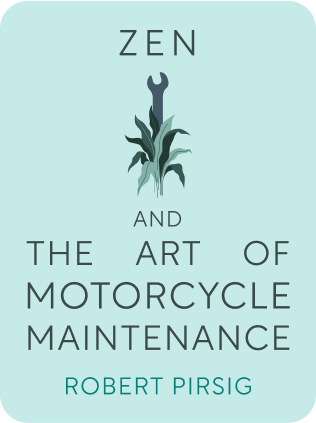

This article is an excerpt from the Shortform book guide to "Zen And The Art Of Motorcycle Maintenance" by Robert Pirsig. Shortform has the world's best summaries and analyses of books you should be reading.
Like this article? Sign up for a free trial here .
What is Phaedrus in Zen and the Art of Motorcycle Maintenance? What role does he play in the story?
In Zen and the Art of Motorcycle Maintenance, Phaedrus is the alter ego of the narrator, Pirsig. Phaedrus’ story is used to help explain larger philosophical ideas.
Read more about Zen and the Art of Motorcycle Maintenance, Phaedrus, and his role in the story.
Zen and the Art of Motorcycle Maintenance: Phaedrus and the First Track
When the book begins, Pirsig and Chris have just left Minneapolis on motorcycles. They are accompanied by John and Sylvia Sutherland, friends of Pirsig, who are riding with the Pirsigs as far as Bozeman, Montana. Whereas Pirsig is an editor of technical manuals, John is a drummer, and their differing attitudes toward motorcycle maintenance provide the impetus for Pirsig’s early Chautauquas on technology.
As the riders make their way west, the Pirsigs’ backstory is slowly revealed. The key plot points are as follows:
- Some years before the ride, Pirsig suffered a mental breakdown and was institutionalized. He was treated with electroshock therapy, which caused him to forget who he was before the treatment. Through occasional fragments of memory and his own research, he’s been able to get a sense of the person he was before. He calls this person Phaedrus.
- In Zen and the Art of Motorcycle Maintenance, Phaedrus was a gifted child who enrolled in college at 15 to study science. He found himself haunted by philosophical questions and eventually flunked out. After a stint in the army, he returned to college to study philosophy.
- After graduating, again consumed by existential questions, Phaedrus spent years in India studying philosophy. He found Eastern philosophy equally as unsatisfying as Western philosophy and returned to the States. He earned a graduate degree in journalism and wound up teaching rhetoric and composition at Montana State University in Bozeman.
- His experience teaching led him to the discovery of “Quality,” an indefinable philosophical concept from which (he thought) sprung all of human experience and endeavor. Both for professional and intellectual reasons, he decided to continue researching “Quality” in an interdisciplinary graduate program at the University of Chicago. It was while he was living and studying in Chicago that he suffered his breakdown.
- Chris has been causing trouble at home lately. He also suffers from chronic stomach aches, but no doctor has been able to find a physical cause. His caretakers fear he’s at risk of a breakdown as well.
In Bozeman, the group stays with an old colleague of Phaedrus named DeWeese. After a few days, the Sutherlands return to Minnesota, and the Pirsigs press on to California. As they near their destination, Pirsig fears that Phaedrus is reviving in his mind and another breakdown is imminent.
When the Pirsigs reach California, Chris’s mood is at its nadir. Pirsig feels compelled to have a frank talk with him. He tells Chris that he, Pirsig, was once insane, and that the doctors fear Chris will end up insane as well. (Shortform note: The terminology and overall depiction of mental disorders in the book is dated.) In response, Chris descends into a wailing fit. As Chris rocks and cries, Phaedrus speaks through Pirsig, and Chris responds favorably. When Chris asks if Pirsig was really insane, Phaedrus, through Pirsig, says no. Chris suddenly brightens, and the book ends with the Pirsigs cruising along the Pacific coast, reconciled.
Two Ways of Thinking
Pirsig rises at 9:00 am; it’s already too hot to sleep. Licking his wounds from the hard ride the day before, Pirsig walks among the surrounding pines lost in thought. He admits that, as he pursued his Chautauquas, he’d hoped he would only have to refer to Phaedrus’s ideas and not the man himself. It’s clear to him now, however, that he cannot avoid talking about Phaedrus personally any longer. He recalls Chris’s American-Indian friend, whose grandmother said ghosts appear only when someone hasn’t been buried correctly. And that’s the problem: the Zen and the Art of Motorcycle Maintenance Phaedrus character wasn’t buried right.
Presently John and Sylvia rise, and the adults begin packing up and cooking breakfast. Pirsig wakes a resistant Chris by yanking his sleeping bag right out from under him. The adults eat their eggs and bacon; Chris takes one bit of food then says his stomach hurts.
Breakfast over, the adults finish breaking down camp. As Pirsig loads the last of his gear onto his cycle’s luggage rack, he notices his rear tire is surprisingly worn down. There’s a problem with the chain as well, and he unpacks his tools to make the necessary adjustment. As John watches Pirsig loosen and tighten the axle, he expresses amazement; he says he wouldn’t even know where to start with an adjustment like the one Pirsig is making. Pirsig, exasperatedly, thinks that that is the whole reason for the Chautauquas, but he tells himself to stay patient—that John is worth teaching. Soon enough the group is on the road again. It’s a picturesque day, and Pirsig has ample time to return to the Chautauquas.
Zen and the Art of Motorcycle Maintenance: Phaedrus and the Classical/Romantic Dichotomy
Phaedrus, Pirsig finally tells us, was a misunderstood and now-forgotten philosopher. In an ideal world, Phaedrus would stay forgotten, but Pirsig believes he must address Phaedrus head on to exorcise and bury him forever.
Unlike the Sutherlands—and much like Pirsig himself—Phaedrus viewed the world entirely in terms of its underlying form. To properly illustrate the qualities of this particular worldview, Pirsig deploys an admittedly broad but useful dichotomy:
Classical Understanding. A person of classical understanding is rational, scientific, unemotional, cerebral, and technologically savvy. She is more concerned with the underlying form of things than the appearance of things—that is, she cares more about how a thing works than how it looks. Motorcycle maintenance, for example, is classical all the way.
Romantic Understanding. A romantic, oppositely, is intuitive, emotional, creative, and artistically inclined. He is more concerned with immediate appearances than underlying forms—he values aesthetics over utility. Motorcycle riding, for example, is romantic.
Each mode of understanding features in the other. For example, a romantic sees the classical mode of understanding as boring, robotic, overly deliberative—oppressive. A classic, meanwhile, sees the romantic mode as silly, impetuous, irrational—dangerous.
The two modes are, by all appearances, irreconcilable; and Pirsig traces the tumult of the Sixties to the deep antagonism between the classical (“square”) and the romantic (“hip”).
Phaedrus’s ideas concerned this perennial divide, but he was ignored, then dismissed, and eventually considered insane. Pirsig opines the insanity was real but caused by people’s opinion of Phaedrus and his ideas rather than an illness. Phaedrus’s end came in the form of an arrest and the permanent removal from society.
The riders stop for gas, and Chris says he’s hungry. Pirsig tells him he either eats with everyone else or not at all. Soon enough they’re back on their cycles. The road they’re traveling is in disrepair and there’s traffic; the sun is bright and the weather sweltering. Pirsig escapes the rough riding by meditating further on the classical world of the Zen and the Art of Motorcycle Maintenance Phaedrus character.

———End of Preview———
Like what you just read? Read the rest of the world's best book summary and analysis of Robert Pirsig's "Zen And The Art Of Motorcycle Maintenance" at Shortform .
Here's what you'll find in our full Zen And The Art Of Motorcycle Maintenance summary :
- How an unnamed narrator and his son are on a cross-country motorcycle journey
- Why technology can be creative
- How to focus on what's in front of you in order to get exactly what you need






